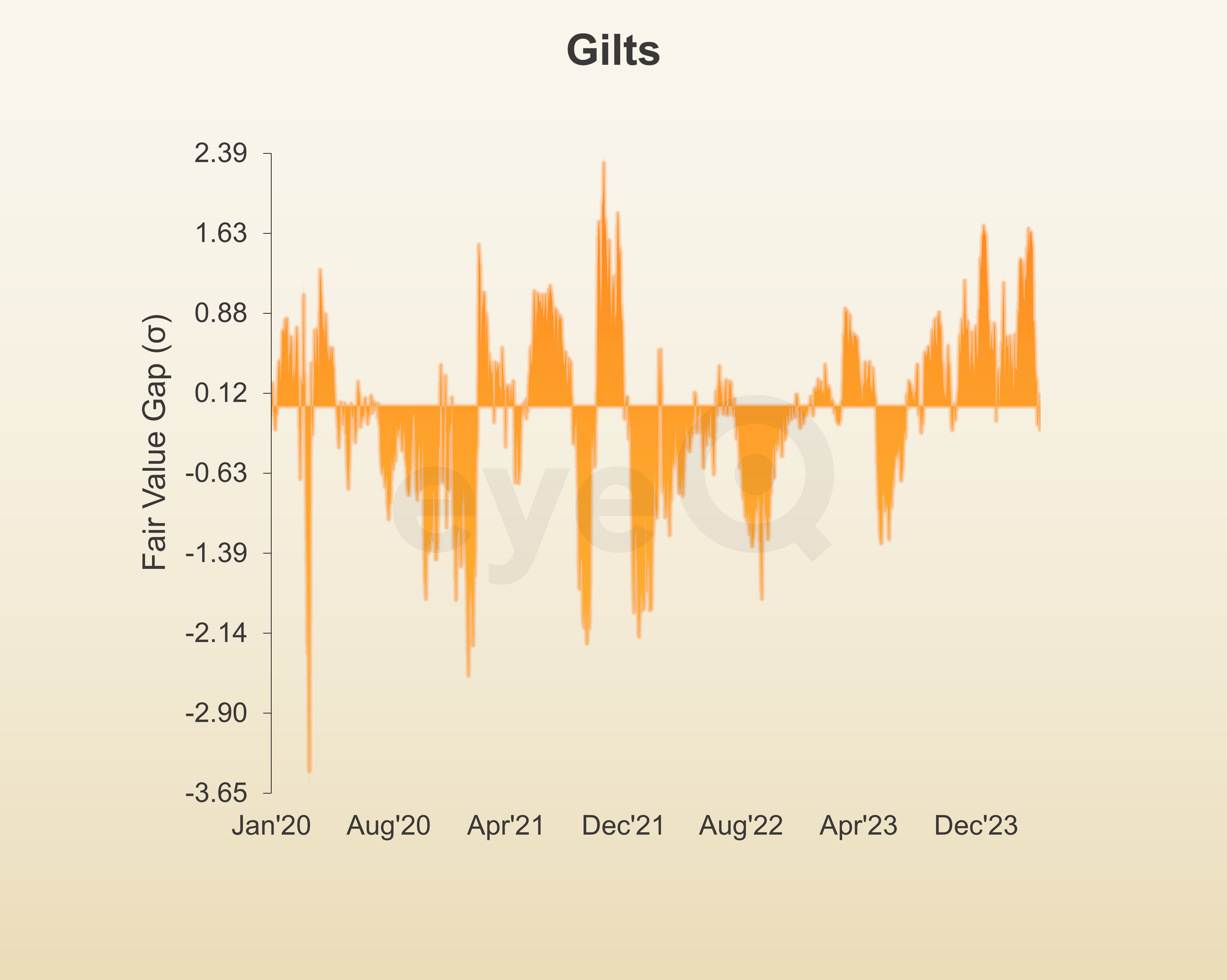eyeQ round-up: FTSE 100, Endeavour Mining, Rio Tinto, gilts
interactive investor has teamed up with the experts at eyeQ who use artificial intelligence and their own smart machine to analyse macro conditions and generate actionable trading signals. Here’s how some of their calls have worked so far.
18th April 2024 08:59
by Huw Roberts from eyeQ

"Our signals are crafted through macro-valuation, trend analysis, and meticulous back-testing. This combination ensures a comprehensive evaluation of an asset's value, market conditions, and historical performance." eyeQ
- Discover: eyeQ analysis explained | eyeQ: our smart machine in action | Glossary
Time to re-visit some of our recent signals to see how eyeQ’s smart machine has been performing. Painful as it is, let’s start with what’s gone wrong.
At the end of February, iShares Core FTSE 100 ETF GBP Dist (LSE:ISF), the exchange-traded fund (ETF) that tracks the FTSE 100, screened as 1.69% rich to macro conditions (current share price above our model value). We acknowledged that UK equities were cheap versus their international peers, but whereas other equity markets had decent momentum (ie. macro conditions were improving), our model value for ISF was falling at that time. The machine issued a bearish signal and our conclusion was that there were better options for equity bulls to consider.
ISF has rallied 2.5% since then. In an “everything rally” where all risky assets - equities, commodities, crypto - were up across the board, ISF was caught up in the ride, helped in particular by the FTSE’s strong commodity bias. Note, for example, BP (LSE:BP.) and Shell (LSE:SHEL) alone account for nearly 14% of the FTSE 100. Given crude oil has increased around 8% in that time, we probably shouldn’t be surprised that the FTSE joined the global equity party.
So, what’s worked? Well, despite getting the FTSE 100 call wrong, the machine has been constructive on commodity and resource stocks. It flashed bullish signals on BHP Group Ltd (LSE:BHP) (which rallied 3.5%) and Rio Tinto Registered Shares (LSE:RIO) (up 8.5%) at the end of February. At its peak, Endeavour Mining (LSE:EDV) was up 33% from our signal early in February! All three signals have closed.
Finally, UK Government Bonds (gilts), which ii clients can trade via the iShares Core UK Gilts ETF GBP Dist (LSE:IGLT). While not the most closely followed part of the market, to our minds it has been the most important recently. At the start of April our “What to do about gilts?” note argued that IGLT was rich to macro and vulnerable to bad news on inflation.
The resilience of recent inflation data in both the UK and US has prompted a significant re-pricing in bond markets. At the start of 2024, markets expected the Federal Reserve to cut six or possibly seven times this year. Today, markets are discounting just one rate cut from the Fed.
In the UK, the timing of the first rate cut has been pushed out from this summer to November. This is critical because the tentative green shoots we’ve seen in the UK housing market, for example, have come from hopes around lower mortgage rates. Think about our recent note on Persimmon (LSE:PSN), for example.
The ETF has fallen 1.6% since then and, on eyeQ, is now back at model fair value (where our model says the stock “should” trade given UK growth rates, the inflation outlook and more). Of course, it could overshoot into cheap territory. What happens next in bonds will be critical for all investors. Equity bulls will be hoping a lot of the bear move has now happened. No rate cuts is OK for stocks if the economy is strong and earnings are healthy. A bond market that starts to move into pricing a return to rate hikes would be a much scarier prospect.

Source: eyeQ. Past performance is not a guide to future performance.
Useful terminology:
Model value
Where our smart machine calculates that any stock market index, singe stock or exchange-traded fund (ETF) should be priced (the fair value) given the overall macroeconomic environment.
Model (macro) relevance
How confident we are in the model value. The higher the number the better! Above 65% means the macro environment is critical, so any valuation signals carry strong weight. Below 65%, we deem that something other than macro is driving the price.
Fair Value Gap (FVG)
The difference between our model value (fair value) and where the price currently is. A positive Fair Value Gap means the security is above the model value, which we refer to as “rich”. A negative FVG means that it's cheap. The bigger the FVG, the bigger the dislocation and therefore a better entry level for trades.
Long Term model
This model looks at share prices over the last 12 months, captures the company’s relationship with growth, inflation, currency shifts, central bank policy etc and calculates our key results - model value, model relevance, Fair Value Gap.
These third-party research articles are provided by eyeQ (Quant Insight). interactive investor does not make any representation as to the completeness, accuracy or timeliness of the information provided, nor do we accept any liability for any losses, costs, liabilities or expenses that may arise directly or indirectly from your use of, or reliance on, the information (except where we have acted negligently, fraudulently or in wilful default in relation to the production or distribution of the information).
The value of your investments may go down as well as up. You may not get back all the money that you invest.
Equity research is provided for information purposes only. Neither eyeQ (Quant Insight) nor interactive investor have considered your personal circumstances, and the information provided should not be considered a personal recommendation. If you are in any doubt as to the action you should take, please consult an authorised financial adviser.
Disclosure
We use a combination of fundamental and technical analysis in forming our view as to the valuation and prospects of an investment. Where relevant we have set out those particular matters we think are important in the above article, but further detail can be found here.
Please note that our article on this investment should not be considered to be a regular publication.
Details of all recommendations issued by ii during the previous 12-month period can be found here.
ii adheres to a strict code of conduct. Contributors may hold shares or have other interests in companies included in these portfolios, which could create a conflict of interests. Contributors intending to write about any financial instruments in which they have an interest are required to disclose such interest to ii and in the article itself. ii will at all times consider whether such interest impairs the objectivity of the recommendation.
In addition, individuals involved in the production of investment articles are subject to a personal account dealing restriction, which prevents them from placing a transaction in the specified instrument(s) for a period before and for five working days after such publication. This is to avoid personal interests conflicting with the interests of the recipients of those investment articles.